There are many different reasons to cover this 1966 Chevrolet Caprice station wagon, the most obvious being that it’s a full-size ’60s vintage wagon and they are certainly popular right now. These Chevy Caprice/Kingswood/Kingswood Estate and Ford Country Squires get most of our press but that’s largely due to their outsized production numbers – there’s just that many still either roaming America’s roads or squirreled away somewhere waiting for their next lease on life. Let’s take a look at this subject car and I’ll point out what I think is interesting. This top-drawer Chevy wagon is located in Santa Paula, California and is available, here on craigslist for $22,500. Thanks to Pat L for this tip!
First up is the model designation. From ’58 into ’65, Chevrolet’s uber-hot selling Impala was as good as it got. Mid-model-year ’65 saw the introduction of the Caprice four-door hardtop, ostensibly as a bulwark against Ford’s recently released top dog LTD. But the four-door Caprice hardtop was all she wrote until the ’66 model year when a formal roofline two-door hardtop and a station wagon were added to the model line-up, so this example is a first year Caprice station wagon. The Caprice name was used through ’68 when the faux wood festooned kiddie/cargo hauler was renamed the Kingswood Estate for ’69. It transitioned its identity to that of “Caprice Estate” in ’73 and then went with “Caprice Classic” in about 1980. The C.C. wagon stayed in the Bowtie’s line-up through ’89 then went on the lam for a year before being reincarnated in ’91 as the Blimpo-inspired Caprice Wagon. By its last hurrah in ’96, the big wagon was back to being known by its formerly used moniker of “Caprice Classic”.
The next point of interest is the engine, a second-year 325 gross HP 396 CI V8 which is said to “run and drive“. It’s a common engine and I can tell you from experience based on several, similarly powered, B-bodies, that I have owned over the last twenty-five years, they’re not out-sized performers in a full-size car. There’s an enormous difference between the go factor when this engine is saddled with 4,200 lbs. of B-Body girth and working through an automatic transmission vs a 3,500 lb. Chevelle, spinning a four-speed manual transmission – the configuration where the 396 made its bones – and its reputation. Both, however, trade on the marketing prowess of the “396” designation. Don’t get me wrong, this powertrain combination in a full-size wagon is hardly slouch-like, but it probably won’t live up to one’s preconceived expectations either. Of course, as with most Chevrolet V8s of this vintage, it takes little to really wake one of these low-performance Mark IVs up, they respond well to minimal mods. A Turbo-Hydramatic 400, three-speed automatic transmission, still pretty new to the Chevrolet Division in ’66, is in place – good news as the outdated Powerglide was still on the option sheet too. And one last point of interest, the master cylinder is a two-circuit version, mandated by law starting in model year ’67. I know every other ’66 that I have encountered, including my own Impala, was straddled with a questionable single circuit variety.
But the really interesting thing that caught my attention is the A.I.R. pump. This is a California-born and reared car (the VIN listing is rubbish but the “L” more than likely stands for the Los Angeles plant in Van Nuys), so it was built to comply with California’s specific air quality regulations that were ultimately administered by the California Air Resources Board (CARB). CARB is an agency that predated the EPA and went about setting its own emission control standards for the Golden State – this being done at a time when there were essentially none other mandated elsewhere in the U.S. Usage of the A.I.R. pump became more prominent over the years and showed up on some of Chevrolet’s more remarkable, high-performance, non-California residents, and as is often the case, became simpler and less “hose-intensive” over time. Most remarkable is the fact that it’s still in place and someone didn’t give it the 23 Skidoo a long time ago.
The exterior of this station wagon, claimed to be wearing its original finish, is in pretty surprising shape. Its non-corroded aspect isn’t so surprising, that’s often the case for a SoCal car. It’s the fact that the Mist Blue lacquer finish and its DiNoc timber sides aren’t more faded than they are. Of course, upon closer review, the timbering appears to have been painted brown so that could be the reason for the overly clean side appearance. Of note are the taillights, the Caprice hardtops used a single fixture, containing multiple bulbs but the station wagon chose a two-element fixture per side, more in keeping with the stern end of a BelAir or Biscayne. As is often found, the rear bumper is a bit shoved in – a common problem for a ’66, both front and back. The bumpers were less about bumping and more about style.
The mileage is listed as 77K but there is no claim to authenticity. Based on the interior, it’s hard to render a mileage judgment. The front seat area still presents pretty well – minus the carpet. It’s not the same deal out back in the cargo area. The rear-facing third seat looks like it has spent most of its life in the closed position but the upholstery panels on either side have either been on the receiving end of a lot of errant cargo hauling or weather exposure. All-in-all, the environment is in fair shape.
These few notables are the maybe not so obvious facets of this car that caught my attention. The remaining one is the price, $22,500? I’m having a tough time with that one. I know values for anything on wheels and deemed “collectible” have become stratospheric but this case makes me wonder if that previously referenced “396” marketing nomenclature, as in “SS396”, is causing a little association bleed-over. Nice try, but I don’t think it will work, how about you?
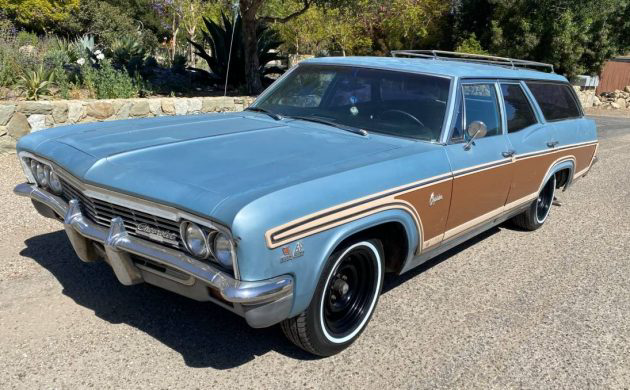
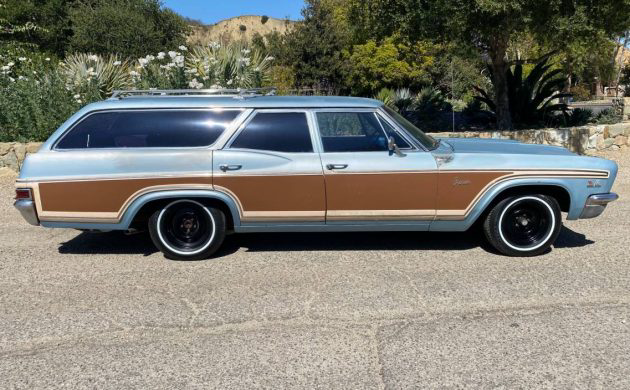


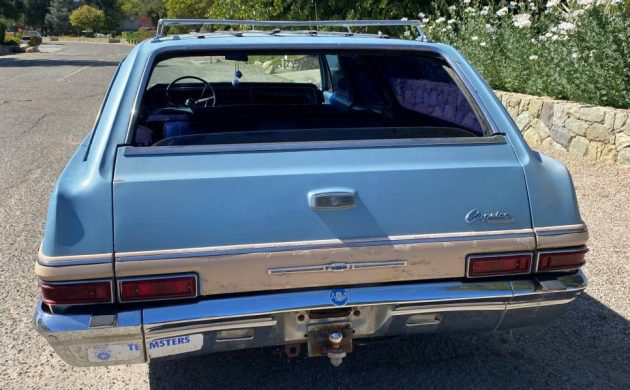
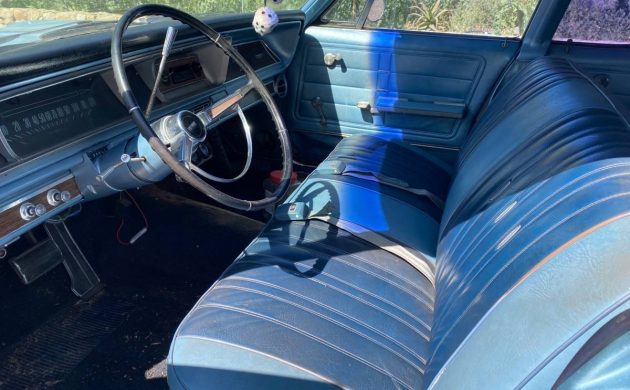
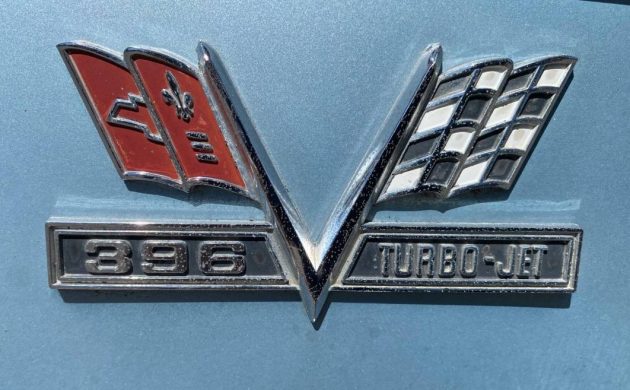


I’m curious to the long cylindrical thingamajigy that looks like its attached to the power steering pump, a cooler of some sort ? I never seen that before….anyone know?
It could be a power steering fluid cooler. My first guess was a transmission fluid cooler.
Definitely not a cooler otherwise it wouldn’t be neoprene wrapped. More like an accumulator for the a/c wrapped so it won’t sweat all over the inner fender.
Yes it is the accumulator, there isn’t one on the heater core inlet where they usually reside.
With Jack – what I can see this isn’t an original factory equipped car…..dual master cylinder didn’t come out until next year and that one is a few years beyond that.
If J.C. Whitney had sold stick-on fake wood paneling for station wagons (I don’t believe they did) it would have looked like this car.
As having owned one of these, they are
not too fast – even with the 427- although the extra cubes help. As Jim says in the article, the extra weight makes a difference – not to mention a highway friendly 2.73 rear gear. Being that this is CA market car, the standard ratio then becomes a 3.07.
Maybe this item has a 3:31 – speculative, based on this example with the extra cooling and hitch (I spy an under dash four-way hazard switch, too).
That dual bale master cylinder was optional for power disc (only) brake equipped Chevys starting in ’67, to ’70 That proportioning valve is not in the factory spot! (See the attached picture).
Rims are the standard for all wagons correct deep(er) dish factory 14×6 JK rims. Those are nice to have! Glad they left off the wheel covers to show us.
Someone definitely painted the area where the 3M woodgrain applique (DiNoc) should be – in fact, it goes over those plastic surround mouldings that always turn a lighter shade.
These are called (officially) Caprice Custom wagons.
My wife loves to drive ours. Fast. And she demands cold A/C and a competent navigator. Such a dilemma, I know…
Got to say that at $22 large I’d expect this $1,200 boat to be in concourse condition.
Yes I am a realist, cheap sure. But I hate where the world is that no one can afford anything anymore and everyone wants to retire off of every sale.
1200 dollars ?!? , uhmmm it always been worth more than 1200,, cheap is one thing, a compete lack of sense and value is another.
This wagon is a very useable and presentable example of quality American made muscle,
maybe 22k is steep, but, its and asking price,,
its for someone who loves it and wants to enjoy amd make memories, not for flippers.
Offer 16k, and might get to drive it home.
My father bought one new and ours was white with the wonderful pretend wood and luggage rack. This was ordered with a 396 and ours had chrome valve covers and an open element air cleaner. This was quite a surprise for service station attendants, yeah remember them? I was 15 and remember the green interior had the factory tinted glass and AC. Dad owned a business and local Chevy/Olds dealer was a good friend. Not sure what boxes were checked but that wagon would pull that 20 ft travel trailer. Oh yeah when I was 16 it would turn the tires.
I have a nice ‘66 396 Impala s/w, factory a/c, p/s and p/b with added disc brake and 2”drop spindles.wheels are chrome rallies with flat caps. Note a concourse vehicle but I have had offers up to $30k. I know it’s crazy, but it is unmolested wagon, no rot, no rust with original drivetrain. I love it and I enjoy cruising the So.Cal. coast. Who knows if the bottom will fall out of wagon prices?? My son wants it carrying the tradition of plywood and surfboards.
This particuer wagon is the rarest of all Caprices made..about 11 or 12 thousand were assembled..to find one in this decent of shape overall is remarkable